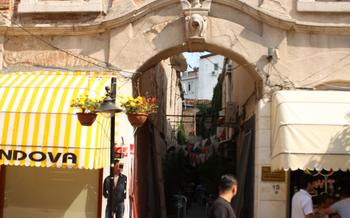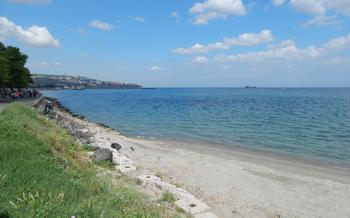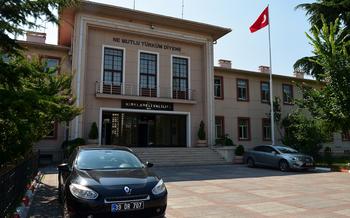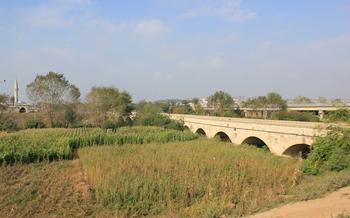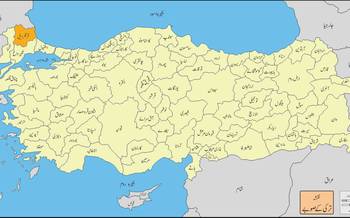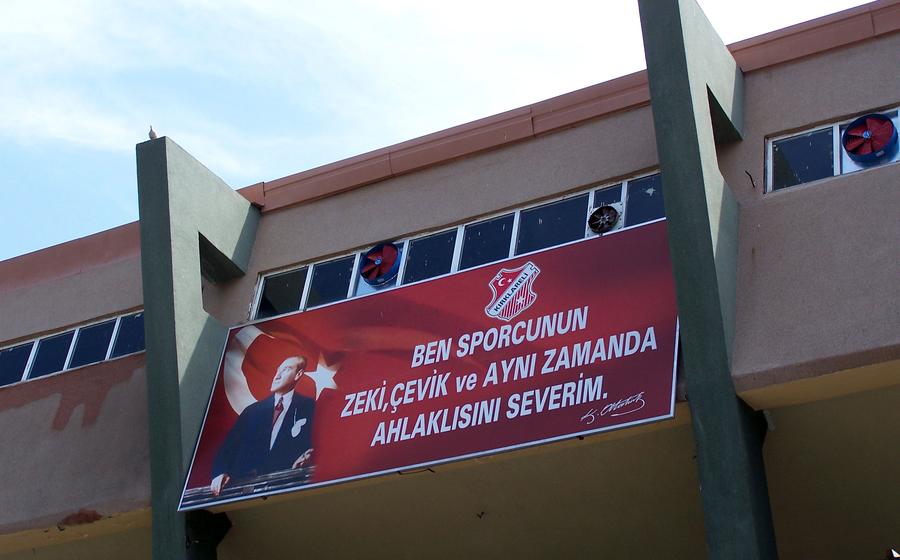
Babaeski Taş Bridge
- History of the Babaeski Taş Bridge
- Architectural Design
- Location and Accessibility
- Best Time to Visit
- Things to See and Do
- Visitor Etiquette
- Local Cuisine
- Accommodation Options
- Safety Tips
- Photography Opportunities
- Cultural Insights
- Local Festivals and Events
- Sustainable Tourism
- Insider Tip: Unveiling the Enchanting Village of Erikli
History of the Babaeski Taş Bridge
The Babaeski Taş Bridge stands as a testament to the rich historical heritage of Kırklareli, Turkey. The region has served as a significant crossroads, where ancient trade routes connected Europe and Asia, facilitating the exchange of goods and ideas. During the Roman Empire's reign, this strategic location led to the construction of the Babaeski Taş Bridge, a majestic structure that has endured the passage of time. Throughout history, the bridge has witnessed countless travelers, merchants, and soldiers traversing its path, shaping the cultural tapestry of the region. Its strategic importance ensured its preservation and continued use, making it a symbol of resilience and connectivity.
Architectural Design
The Babaeski Taş Bridge stands out for its unique structural features, embodying the ingenuity of ancient engineering. The bridge's most striking characteristic is its arch design, a testament to the advanced construction techniques of the Roman Empire. The arches, composed of precisely cut stone blocks, create a graceful and sturdy structure that has withstood the test of time.
The use of local stone materials adds to the bridge's authenticity and reflects the region's rich geological heritage. The stones, quarried from nearby hills, exhibit variations in color and texture, creating a visually captivating pattern. The overall architectural style of the bridge blends seamlessly with the surrounding landscape, showcasing the harmony between human creation and the natural environment.
The bridge's design showcases the Romans' mastery of hydraulics, as it effectively manages the flow of the Ergene River beneath it. The piers, positioned strategically, minimize the impact of the river's currents on the bridge's stability. This thoughtful engineering ensures the bridge's longevity and resilience against the forces of nature.
Location and Accessibility
The Babaeski Taş Bridge is situated in the mesmerizing town of Babaeski, nestled within the province of Kırklareli in northwestern Turkey. This historic bridge stands as a testament to the region's rich past and serves as a captivating attraction for travelers seeking to delve into Turkey's cultural heritage.
Reaching the bridge is a straightforward endeavor, offering visitors multiple transportation options. Whether you prefer the convenience of a rental car, the flexibility of public buses, or the scenic charm of a leisurely train ride, you'll find that getting to the Babaeski Taş Bridge is a breeze.
For those arriving by car, simply follow the well-maintained roads leading to Babaeski. Once in town, signs will guide you directly to the bridge. Public transportation is equally convenient, with buses departing regularly from Kırklareli and neighboring towns, ensuring a hassle-free journey to the bridge's doorstep.
Train enthusiasts will delight in the opportunity to travel aboard the regional rail line, offering breathtaking views of the countryside as it meanders through picturesque landscapes. Disembarking at the Babaeski station, a short walk or a quick taxi ride will bring you to the bridge.
Once you arrive, ample parking spaces are available, ensuring a stress-free start to your exploration of this ancient marvel. The bridge's accessible design caters to visitors of all abilities, providing ramps and designated pathways for wheelchairs and strollers, making it an inclusive destination for all.
Surrounding the bridge, you'll discover an array of attractions waiting to be explored. Immerse yourself in the town's rich history at the Babaeski Museum, stroll through the vibrant local markets, or savor the delectable flavors of traditional Turkish cuisine at nearby restaurants. The Babaeski Taş Bridge serves as a gateway to a world of cultural wonders, inviting you to embark on an unforgettable journey through time and tradition.
Best Time to Visit
The ideal time to visit Kırklareli and the Babaeski Taş Bridge is during the spring (April-May) and autumn (September-October), when the weather is pleasant and mild. The temperatures range from a comfortable 15°C to 25°C, making it perfect for outdoor exploration and sightseeing.
For photography enthusiasts, the early morning and late afternoon offer the best light for capturing stunning shots of the bridge against the backdrop of the picturesque landscape. The golden hues of sunrise and sunset cast a magical glow on the ancient structure, creating a breathtaking spectacle.
To avoid crowds and enjoy a more peaceful experience, it's advisable to visit during weekdays or off-season. This will allow you to fully immerse yourself in the historical charm of the bridge and its surroundings without the hustle and bustle of peak tourist periods.
Additionally, local events and festivals throughout the year can enhance your visit. The Kırklareli Culture and Arts Festival in August showcases traditional music, dance, and local crafts, providing an opportunity to delve deeper into the region's rich cultural heritage.
Things to See and Do
The Babaeski Taş Bridge stands as a testament to the rich history and enduring spirit of Kırklareli. Beyond its historical significance, the bridge offers a plethora of opportunities for visitors to explore and experience the vibrant culture and natural beauty of the region.
Start by immersing yourself in the serene surroundings of the bridge. Stroll along its ancient stone path, marveling at the architectural details that have stood the test of time. Capture the picturesque vistas of rolling hills, lush forests, and meandering rivers that paint a breathtaking backdrop for the bridge.
Venture beyond the bridge to discover the hidden gems of the region. Explore nearby historical sites, such as ancient ruins, medieval castles, and traditional villages that offer a glimpse into the past. Delve into the local museums to uncover the fascinating stories and artifacts that tell the tale of Kırklareli's diverse heritage.
Embrace the region's love for the outdoors with a range of activities that cater to every traveler's preferences. Embark on a leisurely hike through the picturesque landscapes, following ancient paths that once carried travelers from distant lands. Cycle along scenic routes that wind through charming villages and offer breathtaking panoramas of the countryside. Find a secluded spot for a picnic, savoring local delicacies while immersing yourself in the tranquility of nature.
Indulge in the vibrant local culture by visiting traditional markets or attending festivals that showcase the region's rich traditions. Browse through stalls laden with handcrafted souvenirs, textiles, and culinary delights that reflect the unique artistry and flavors of Kırklareli. Engage with the friendly locals, eager to share their stories, customs, and warm hospitality that make this region so special.
Visitor Etiquette
When visiting the Babaeski Taş Bridge and its surroundings, it is important to be mindful of local customs and traditions. To ensure a respectful and enjoyable experience, here are some guidelines to follow:
-
Respect the Site: The bridge is a historical landmark and should be treated with respect. Avoid climbing on the bridge, damaging its structure, or littering in the area.
-
Be Considerate of Others: The bridge is a popular tourist destination, so be considerate of other visitors. Avoid loud noises or disruptive behavior that might disturb their enjoyment of the site.
-
Ask Permission: Before taking photographs of people, especially locals, always ask for their permission first. This shows respect for their privacy and helps to avoid any misunderstandings.
-
Stay on Designated Paths: To protect the surrounding environment, stay on designated paths and avoid venturing into restricted areas. This helps to preserve the natural habitats and prevent damage to sensitive ecosystems.
-
Be Open to Interaction: Locals are typically friendly and welcoming, so don't hesitate to engage in conversations or ask for directions or recommendations. Interacting with locals can provide a deeper insight into the region's culture and way of life.
Local Cuisine
When visiting the Babaeski Taş Bridge, take advantage of the opportunity to explore the local culinary delights. Kırklareli is renowned for its rich and diverse cuisine, influenced by both Turkish and Balkan traditions. Indulge in must-try dishes like "Kırklareli Köftesi," succulent meatballs grilled to perfection and served with a tangy tomato sauce. Savor the flavors of "Kavala Kurabiyesi," delicate almond cookies that melt in your mouth, or "Kırklareli Peyniri," a creamy and flavorful cheese produced locally. Explore local markets for fresh produce, aromatic spices, and traditional Turkish sweets. Vegetarians and those with dietary restrictions can find plenty of options, such as "Zeytinyağlı Yaprak Sarma," tender grape leaves stuffed with rice and herbs, or "Gavurdağı Salatası," a refreshing salad made with roasted red peppers and walnuts. Embrace the local culinary culture and embark on a gastronomic journey that will leave your taste buds tantalized.
Accommodation Options
When planning your visit to the Babaeski Taş Bridge, you'll have a range of accommodation options to choose from, catering to different budgets and preferences.
-
Hotels and Guesthouses: For a comfortable and convenient stay, consider booking a room in one of the nearby hotels or guesthouses. These establishments offer a variety of amenities, including comfortable beds, private bathrooms, and often additional services like breakfast or room service.
-
Homestays and Bed and Breakfasts: If you seek a more immersive cultural experience, opt for a homestay or bed and breakfast. These accommodations provide a unique opportunity to interact with local families and gain insights into their way of life. You'll often be treated to traditional Turkish hospitality and home-cooked meals.
-
Camping and Caravan Parks: For outdoor enthusiasts and nature lovers, camping or caravan parks offer a budget-friendly and adventurous option. These facilities provide designated areas for tents or caravans, along with basic amenities like restrooms and showers. They're a great choice for those who want to fully embrace the natural beauty of the region.
-
Advance Booking Recommendations: During peak tourist seasons, it's advisable to book your accommodation in advance to avoid disappointment. This is especially important if you have specific preferences or require special arrangements. Online booking platforms and local travel agents can assist you in finding the ideal place to stay.
Safety Tips
Kırklareli is generally a safe city for tourists, but it's essential to exercise caution, especially when visiting historical sites and venturing into unfamiliar areas. Here are some safety tips to keep in mind:
-
Be aware of your surroundings: Pay attention to your surroundings and be cautious of people who may approach you with unsolicited offers or requests.
-
Keep your valuables safe: Secure your belongings, such as your passport, money, and credit cards, in a safe place. Avoid carrying large amounts of cash, and consider using a money belt or RFID-blocking wallet.
-
Be cautious when taking photographs: Ask for permission before taking pictures of people, especially women, and religious or military sites.
-
Be mindful of local customs: Respect local customs and traditions, such as dressing modestly and avoiding public displays of affection.
-
Learn a few Turkish phrases: Basic Turkish phrases can help you communicate with locals and avoid misunderstandings.
-
Stay connected: Keep your mobile phone charged and have emergency contact information handy. Learn the local emergency numbers (112 for police, 110 for fire, and 118 for ambulance).
-
Trust your instincts: If a situation feels unsafe, trust your instincts and remove yourself from it.
-
Report any incidents: If you experience any harassment, theft, or other incidents, report them to the local police or your embassy.
Photography Opportunities
The Babaeski Taş Bridge presents a captivating subject for photography enthusiasts. Its picturesque setting amidst the lush greenery and the backdrop of the distant mountains creates an idyllic scene. The intricate details of the bridge's architecture, with its graceful arches and weathered stonework, offer ample opportunities for capturing stunning images.
Whether you're an amateur photographer or a seasoned professional, the bridge provides a canvas to showcase your skills. Experiment with different angles and perspectives to highlight its unique features. Photograph the bridge under the warm glow of sunrise or sunset for dramatic and vibrant shots.
Utilize the natural light conditions to your advantage. The golden hues of early morning or late afternoon can create a magical atmosphere, enhancing the bridge's grandeur. Don't forget to experiment with different shutter speeds to capture the flowing water beneath the bridge or create a sense of movement and energy.
Share your photographic journey on social media platforms, using relevant hashtags to connect with fellow photography enthusiasts and inspire others to explore the beauty of the Babaeski Taş Bridge. Your images can serve as a testament to the bridge's enduring legacy and the captivating charm of Kırklareli.
Cultural Insights
The Babaeski Taş Bridge stands as a testament to the rich cultural heritage of Kırklareli, Turkey. To fully appreciate the significance of this ancient structure, it is essential to delve into the local customs and traditions that have shaped its history and meaning for the community.
Interact with the locals to gain insights into their way of life and the stories that have been passed down through generations. Learn about the significance of the bridge in local folklore and mythology, and how it has influenced the cultural identity of the region.
Participate in cultural events or workshops to immerse yourself in the vibrant tapestry of Turkish traditions. Attend local festivals, where you can witness traditional music, dance, and cuisine, and experience the warmth and hospitality of the people of Kırklareli.
By embracing the local culture, you will gain a deeper appreciation for the Babaeski Taş Bridge and its role in shaping the unique identity of this historic region.
Local Festivals and Events
The Babaeski Taş Bridge and its surroundings play host to several annual festivals and events that celebrate the region's rich cultural heritage. These events offer a vibrant and immersive experience for visitors who wish to delve deeper into the local traditions and way of life.
One of the most notable events is the Babaeski Taş Köprü Festivali, held annually in the summer. This festival showcases the history and significance of the bridge through various activities, including traditional music and dance performances, historical reenactments, and local crafts demonstrations. Visitors can enjoy live music, sample delicious Turkish cuisine, and witness the vibrant energy of the local community.
Another popular event is the Kırklareli Kültür ve Sanat Festivali, which takes place in the spring. This festival celebrates the diverse cultural traditions of Kırklareli, showcasing local art, music, and handicrafts. Visitors can explore exhibitions, attend workshops, and enjoy performances by local artists, gaining a deeper understanding of the region's creative spirit.
By attending these local festivals and events, visitors can immerse themselves in the vibrant culture of Kırklareli, experience the warmth and hospitality of the local people, and create lasting memories of their time at the Babaeski Taş Bridge.
Sustainable Tourism
As you embark on your journey to the Babaeski Taş Bridge, embrace the principles of responsible tourism to preserve the natural beauty and cultural heritage of the region. Minimize your ecological impact by opting for public transportation or exploring the surroundings on foot. Support local businesses that prioritize sustainability, such as restaurants using locally sourced ingredients or hotels implementing eco-friendly practices. Remember, leaving no trace and respecting the environment ensures that future generations can continue to appreciate this historical and scenic landmark.
Insider Tip: Unveiling the Enchanting Village of Erikli
Beyond the captivating Babaeski Taş Bridge, Kırklareli holds another hidden gem just waiting to be discovered: the charming village of Erikli. Nestled amidst rolling green hills and lush forests, Erikli exudes an aura of tranquility and rustic beauty.
As you step into this picturesque village, you'll be greeted by friendly locals who are proud to share their traditions and way of life. Take a leisurely stroll through its cobblestone streets, admiring the traditional Ottoman-style houses adorned with vibrant flowers.
Erikli is renowned for its exquisite local cuisine, featuring fresh, seasonal ingredients and traditional Turkish recipes passed down through generations. Indulge in mouthwatering dishes prepared with love and care at one of the village's cozy restaurants or cafes.
Don't miss the opportunity to visit Erikli's vibrant weekly market, where you can immerse yourself in the lively atmosphere and browse a colorful array of local handicrafts, organic produce, and delectable treats.
For nature enthusiasts, Erikli serves as a gateway to breathtaking hiking trails that wind through the surrounding countryside. Explore the verdant forests, discover hidden waterfalls, and soak in the tranquility of the natural surroundings.
As the sun begins to set, find a secluded spot overlooking the valley and witness a mesmerizing sunset that paints the sky in hues of gold and crimson. Erikli offers a unique blend of history, culture, and natural beauty, ensuring an unforgettable experience for every traveler who ventures beyond the Babaeski Taş Bridge.
